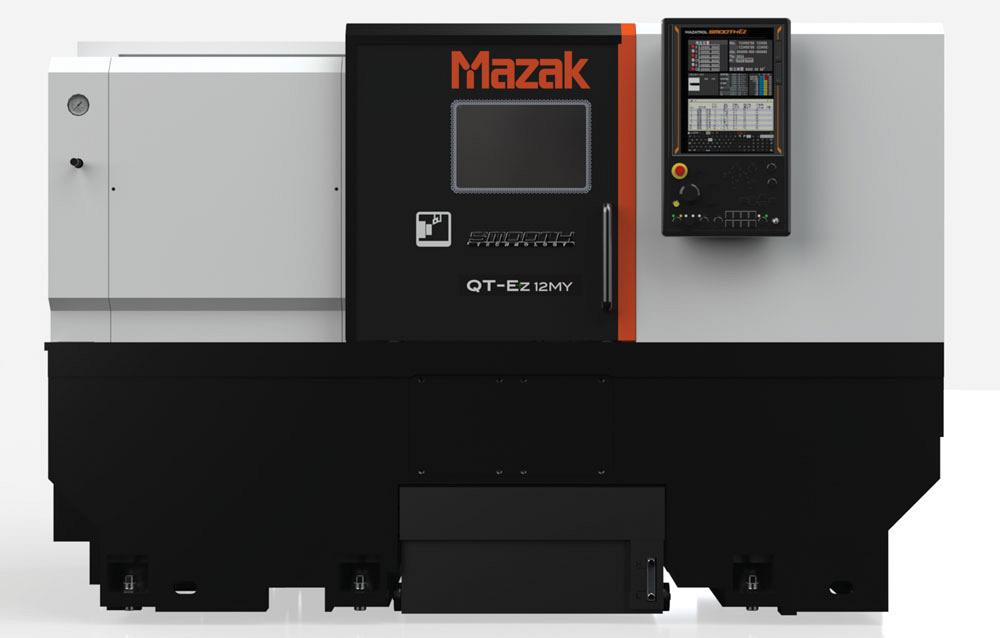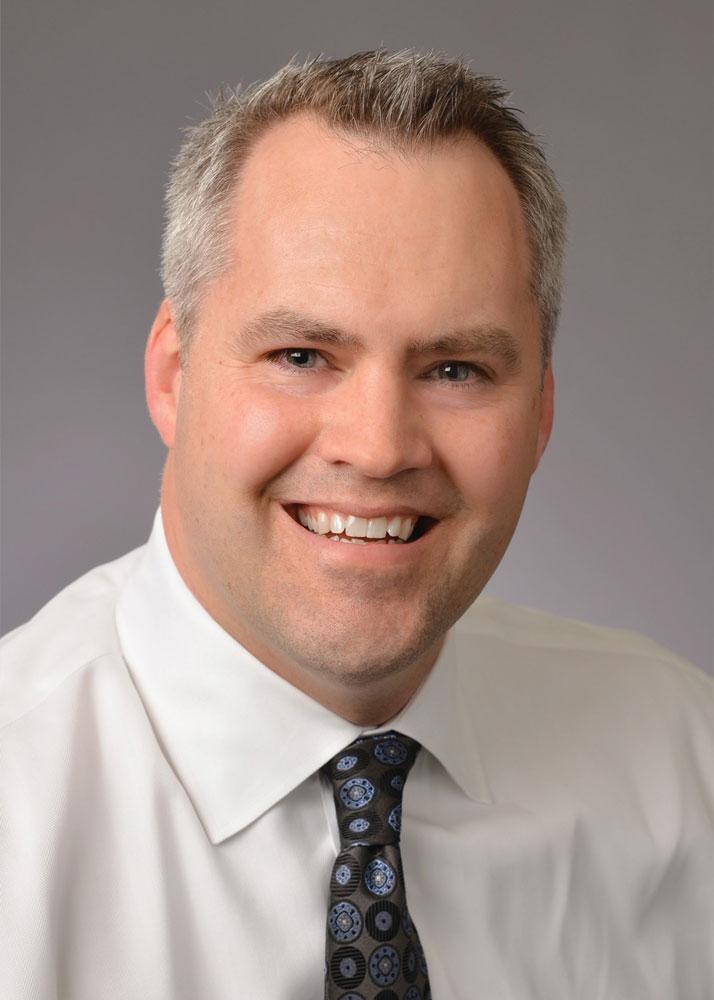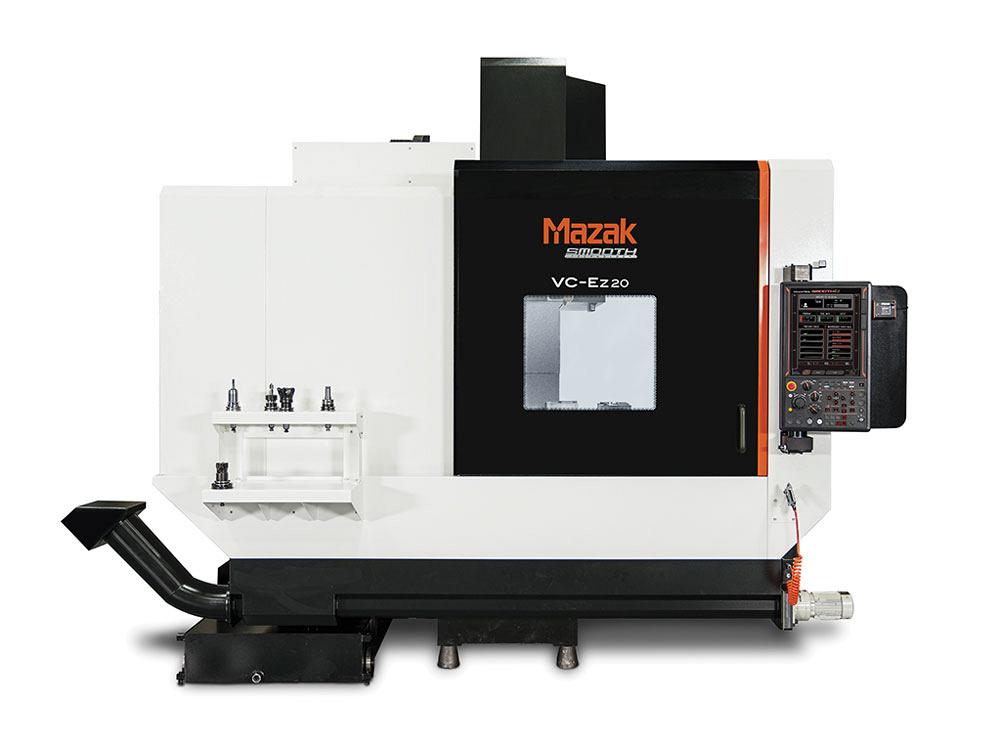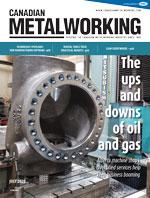Editor
- FMA
- The Fabricator
- FABTECH
- Canadian Metalworking
Supplier Side Talk: Mazak Corp. with Greg Papke
Mazak Corp. has had a presence in North America since 1969
- By Joe Thompson
- August 1, 2022
- Article
- Metalworking

The VC-Ez 20 VMC has a C-frame design with X- and Y-axis motion using a moving table and saddle along with Mazak’s MX linear systems and pretensioned ballscrews.
Mazak Corp. has had a presence in North America since 1969 when it opened its first location on Long Island, N.Y.
In 1974 the company moved its headquarters to Florence, Ky., where the Mazak iSMART Factory creates some of the world’s most advanced manufacturing technologies. For industries like aerospace, medical, and general industrial manufacturing, the company has numerous machining systems to suit job shops and major manufacturers alike.
The company serves Canada from two locations in Edmonton and Cambridge, Ont.
Recently Editor Joe Thompson spoke with Greg Papke, division vice-president, sales and marketing, Advantec at Mazak Corp. about the company’s direction and its new product launch, the Mazak Ez Series, which was designed and built in Kentucky. The equipment is marketed as affordable access to Mazak reliability, accuracy, and performance. Here is part of that discussion.
Thompson: There is a constant flow of new machines and technology coming into the manufacturing marketplace, and a lot of brand choices exist for manufacturing companies. How important is it to have technology differentiators in your equipment, and are these differentiators present in your company’s Ez machines?
Papke: I think that you must try your best to include these technology differentiators even when designing less-complex machines. You want more companies to take advantage of them while not making the machine too complex or too expensive. So, it's a delicate balance.
The genesis of the Ez line of machines happened over a pretty long time. I think we at Mazak Corp. felt that our products were becoming a little bit too sophisticated, perhaps a little too lofty for the average job shop. We really tried to dial that back in some areas to make our machines more broadly appealing.
One of our differentiators that really always has been a differentiator for Mazak is our control. Our interface with the operator and the programmer is very unique because of the Mazatrol programming language.
These machines have a SmoothEz control, which is equipped standard with both Mazatrol conversational and G-code programming. But it extends beyond just programming. We are trying to improve the entire operator experience, and you really can customize your touchscreen layout with the Smooth Ez control.
Thompson: It's never easy to produce a totally new line of machines but doing it during the COVID-19 pandemic obviously must have been tricky. How was the rollout affected by shortages of materials, microchips, or even shipping containers?

"We've always felt it's really important to be close to our customers to listen to what their needs are and then trying to tailor products and options to suit those needs." -- Greg Papke
Papke: Well, initially we started out with one vertical machine called the VC-Ez 20, which is a classic 20-in. by 40-in. VMC model. These, like all of the VC-Ez machines, have a C-frame design with X- and Y-axis motion using a moving table and saddle along with our MX linear systems and pretensioned ballscrews.
We are now unveiling the rest of the vertical machines and also the turning machines. The turning machines are the QT-Ez 8, QT-Ez 10, and QT-Ez 12 models, each offered in a 2-axis, M, MY, and MSY versions.
[Editor’s note: Mazak’s Ez turning series M versions have milling capability, the MY machines have milling capability and Y-axis off-centreline capability, and MSY machines feature a combination of milling and Y-axis capability paired with a second turning spindle.]
The initial rollout was reasonably smooth for us because it was just kind of at the beginning phase of the pandemic, so we had already reinforced our supply chain. So, initially we were able to get the materials and schedule everything fairly efficiently. But over time it got worse.
This year we rolled out the VC-Ez 16 smaller vertical and a VC-Ez 26 and we've had numerous delays in being able to obtain the main castings for the machine, like the base casting, the column, and saddle. So, we've unquestionably experienced many unforeseen delays.
And, of course, costs have risen tremendously over the last year.
Thompson: How important is having a manufacturing space to build your machines close to your North American customers? What role does that play in a successful product launch?
Papke: We've always felt it's really important to be close to our customers to listen to what their needs are and then try to tailor products and options to suit those needs. So, building these machines in the U.S. allows us to respond by adding options that customers want in the factory rather than installing them in the field.
That’s helpful because when they receive the machine it's ready to plug in and use immediately rather than spending a month to fully configure the machine and prove it out.
Thompson: What was the design process like and where was it performed?

The QT-Ez 12MY is a turning centre with both milling capability and Y-axis off-centreline capability.
Papke: The design of the Ez Series was a collaborative effort with our Japan headquarters. There are some aspects that were designed in Kentucky and some that were done in Japan.
Thompson: The tagline for this series is “a machine for every shop.” Do you see it as a departure for the company in terms of your historical customers who are known for very high-end work and parts with complex geometries?
Papke: We always have thought that if we work with smaller shops to grow their capabilities and help make them more proficient, we can help them grow their business together.
If we didn’t have an entry-level machine like the Ez Series that they can learn from and get accustomed to, it’s harder to create relationships down the road. It would be a lot harder to become their supplier in the future.
We knew that we needed to design machines that were comfortable, easy to work with, and more affordable. And that's what we tried to achieve.
Thompson: In a world of supply chain shortages and long delivery times, is there still such a thing as brand loyalty?
Papke: I've been into shops that are very brand loyal to Mazak, and I still do believe there's brand loyalty in the industry.
With our factory in Kentucky, we're trying to be more responsive with short delivery times and shipping machines with all of the options already built-in. Some of the design changes for these machines make it a little easier for us to produce them efficiently, and hopefully this increases the scale of the number of machines we can build so that we can deploy them quicker.
But yes, we are aware of our customers’ need for short delivery times.
Thompson: One thing I noticed about these machines is they seem to be somewhat smaller-footprint machines, but still are available with a lot of options, including multitasking. How do these machines reflect the needs of your customers today?
Papke: Good question. We feel that almost every job shop is suffering from a labour shortage. It's very hard to find people, and so it’s important to get the machine installed quickly and make it easy to maintain.
If these Ez machines make it easier and more affordable for shops to own a machine with multitasking capabilities to reduce setups, reduce the downtime of the machine, and make parts quickly, then you can get on to the next job efficiently.
And, at the end of the day, it's still a Mazak machine with everything that the power of the brand brings.
Mazak Corp., www.mazakcanada.com
About the Author

Joe Thompson
416-1154 Warden Avenue
Toronto, M1R 0A1 Canada
905-315-8226
Joe Thompson has been covering the Canadian manufacturing sector for more than two decades. He is responsible for the day-to-day editorial direction of the magazine, providing a uniquely Canadian look at the world of metal manufacturing.
An award-winning writer and graduate of the Sheridan College journalism program, he has published articles worldwide in a variety of industries, including manufacturing, pharmaceutical, medical, infrastructure, and entertainment.
Related Companies
subscribe now


Keep up to date with the latest news, events, and technology for all things metal from our pair of monthly magazines written specifically for Canadian manufacturers!
Start Your Free Subscription- Trending Articles
Sustainability Analyzer Tool helps users measure and reduce carbon footprint

Mitutoyo updates its end-user portal

Enhance surface finish with high-speed machining

Equispheres secures $20 million investment round

Solid carbide drills produce precision holes in short chipping materials

- Industry Events
Automate 2024
- May 6 - 9, 2024
- Chicago, IL
ANCA Open House
- May 7 - 8, 2024
- Wixom, MI
17th annual Joint Open House
- May 8 - 9, 2024
- Oakville and Mississauga, ON Canada
MME Saskatoon
- May 28, 2024
- Saskatoon, SK Canada
CME's Health & Safety Symposium for Manufacturers
- May 29, 2024
- Mississauga, ON Canada















